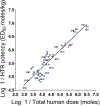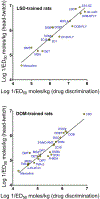Correlation between the potency of hallucinogens in the mouse head-twitch response assay and their behavioral and subjective effects in other species
- PMID: 31917152
- PMCID: PMC9191653
- DOI: 10.1016/j.neuropharm.2019.107933
Correlation between the potency of hallucinogens in the mouse head-twitch response assay and their behavioral and subjective effects in other species
Abstract
Serotonergic hallucinogens such as lysergic acid diethylamide (LSD) induce head twitches in rodents via 5-HT2A receptor activation. The goal of the present investigation was to determine whether a correlation exists between the potency of hallucinogens in the mouse head-twitch response (HTR) paradigm and their reported potencies in other species, specifically rats and humans. Dose-response experiments were conducted with phenylalkylamine and tryptamine hallucinogens in C57BL/6J mice, enlarging the available pool of HTR potency data to 41 total compounds. For agents where human data are available (n = 36), a strong positive correlation (r = 0.9448) was found between HTR potencies in mice and reported hallucinogenic potencies in humans. HTR potencies were also found to be correlated with published drug discrimination ED50 values for substitution in rats trained with either LSD (r = 0.9484, n = 16) or 2,5-dimethoxy-4-methylamphetamine (r = 0.9564, n = 21). All three of these behavioral effects (HTR in mice, hallucinogen discriminative stimulus effects in rats, and psychedelic effects in humans) have been linked to 5-HT2A receptor activation. We present evidence that hallucinogens induce these three effects with remarkably consistent potencies. In addition to having high construct validity, the HTR assay also appears to show significant predictive validity, confirming its translational relevance for predicting subjective potency of hallucinogens in humans. These findings support the use of the HTR paradigm as a preclinical model of hallucinogen psychopharmacology and in structure-activity relationship studies of hallucinogens. Future investigations with a larger number of test agents will evaluate whether the HTR assay can be used to predict the hallucinogenic potency of 5-HT2A agonists in humans. "This article is part of the special issue entitled 'Serotonin Research: Crossing Scales and Boundaries'.
Keywords: Behavioral model; DMT; DOM; Head shake; Mescaline; N,N-dimethyltryptamine; NBOMe; Psilocybin; Psychedelic.
Published by Elsevier Ltd.
Conflict of interest statement
Declaration of competing interest None.
Figures



References
-
- Abiero A, Botanas CJ, Sayson LV, Custodio RJ, de la Pena JB, Kim M, Lee HJ, Seo JW, Ryu IS, Chang CM, Yang JS, Lee YS, Jang CG, Kim HJ, Cheong JH (2019) 5-Methoxy-alpha-methyltryptamine (5-MeO-AMT), a tryptamine derivative, induces head-twitch responses in mice through the activation of serotonin receptor 2a in the prefrontal cortex. Behav Brain Res 359: 828–835. - PubMed
-
- Appel JB, White FJ, Holohean AM (1982a) Analyzing mechanism(s) of hallucinogenic drug action with drug discrimination procedures. Neurosci Biobehav Rev 6: 529–36. - PubMed
-
- Appel JB, White FJ, West WB, Holohean AM (1982b) Discriminative stimulus properties of ergot alkaloids. In: Colpaert FC, Slangen JL (eds) Drug Discrimination: Applications in CNS Pharmacology. Elsevier Biomedical Press, Amsterdam, pp 49–67
-
- Benneyworth MA, Smith RL, Sanders-Bush E (2008) Chronic phenethylamine hallucinogen treatment alters behavioral sensitivity to a metabotropic glutamate 2/3 receptor agonist. Neuropsychopharmacology 33: 2206–16. - PubMed
Publication types
MeSH terms
Substances
Grants and funding
LinkOut - more resources
Full Text Sources
Other Literature Sources

